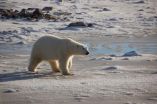(Press-News.org) Polar bears were added to the threatened species list nearly three years ago as their icy habitat showed steady, precipitous decline because of a warming climate. But it appears the Arctic icons aren't necessarily doomed after all.
Scientists from several institutions, including the U.S. Geological Survey and the University of Washington, have found that if humans reduce greenhouse gas emissions significantly in the next decade or two, enough Arctic ice is likely to remain intact during late summer and early autumn for polar bears to survive.
"What we projected in 2007 was based solely on the business-as-usual greenhouse gas scenario," said Steven Amstrup, an emeritus researcher with the U.S. Geological Survey and the senior scientist with the Montana-based conservation organization Polar Bears International. "That was a pretty dire outlook, but it didn't consider the possibility of greenhouse gas mitigation."
That study projected that only about one-third of the world's 22,000 polar bears might be left by mid-century if the dramatic Arctic ice decline continued, and that eventually they could disappear completely. The work led to the 2008 listing of polar bears as a threatened species.
The new research, published in the Dec. 16 issue of Nature, is based in part on modeling proposed by Cecilia Bitz, a UW associate professor of atmospheric sciences. It indicates there is no "tipping point" that would result in unstoppable loss of summer sea ice when greenhouse gas-driven warming rose above a certain threshold.
"Our research offers a very promising, hopeful message, but it's also an incentive for mitigating greenhouse emissions," Bitz said.
Amstrup is the lead author of the Nature paper. Besides Bitz, co-authors are Eric DeWeaver of the National Science Foundation, David Douglas and George Durner of the USGS Alaska Science Center, Bruce Marcot of the U.S. Forest Service in Oregon and David Bailey of the National Center for Atmospheric Research in Colorado.
Because the scientists were looking specifically to see if there is a tipping point beyond which seasonal Arctic ice could not recover, they used a general circulation model with a sea-ice component particularly sensitive to rising temperatures, with major parts of it designed by Bitz.
"We didn't necessarily need to compare with other models since we were using one that is extremely sensitive in the Arctic, which allowed us to make a more conservative statement about the potential to slow the loss of sea ice," she said.
Previous work by Bitz and others showed that unchecked temperature increases, along with natural environmental volatility, could result in the loss of vast areas of Arctic ice in less than a decade. It also showed that with continued business-as-usual greenhouse gas emissions the ice did not recover after such rapid ice losses, and it largely disappeared altogether in following decades.
However, the new Nature study indicates that if greenhouse gas emissions were reduced substantially in the near future, rapid ice losses would be followed by substantial retention of the remaining ice through this century, as well as partial recovery of the ice that disappeared during the rapid ice loss.
Polar bears depend on sea ice for access to ringed and bearded seals, their primary food source. During seasons when they can't reach sea ice, the bears mostly go without food and can lose about 2 pounds a day. The periods when they don't have ice access have increased and are expected to continue increasing with the current level of greenhouse gas emissions.
As part of the current study, the potential sea-ice outlook generated by the general circulation model, as well as many features of polar bear life history, were placed into a network model, which can, for example, examine the relationship between polar bears and their environment. Those results indicated that increased retention of sea-ice habitat because of greenhouse gas mitigation would allow polar bears to survive in greater numbers throughout this century, and in more areas of the Arctic, than would happen with no mitigation.
Amstrup divided the Arctic into four separate ecoregions according to the nature of ice typically found there, and the 2007 study showed a very high likelihood that polar bears would become extinct in two of those regions given current trends in greenhouse gas emissions.
"There's still a fairly high probability in both of those regions that polar bears could disappear," Amstrup said. "But with mitigation and aggressive management of hunting and other direct bear-human interactions, the probability of extinction would now be lower than the probability that polar bear numbers will simply be reduced.
"With mitigation, conditions for polar bears might even improve in the other two ecoregions. The benefit of mitigation to polar bears is substantial."
INFORMATION:
Primary funding for the research came from USGS, with additional funding from the Forest Service, the U.S. Department of Energy and the National Science Foundation.
For more information, contact Amstrup at 406-581-6183 or samstrup@pbears.org, or Bitz at 206-543-1339 or bitz@atmos.washington.edu.
Polar bears still on thin ice, but cutting greenhouse gases now can avert extinction
2010-12-16
ELSE PRESS RELEASES FROM THIS DATE:
deCODE discovers genetic markers that improve the power of PSA testing for detecting prostate cancer
2010-12-16
Reykjavik, ICELAND, 15 December 2010 – Scientists from deCODE genetics and academic colleagues from Iceland, the UK, US, Netherlands, Spain and Romania today report the discovery of a set of single-letter variations in the sequence of the human genome (SNPs) that impact individual baseline levels of prostate specific antigen, or PSA. Testing for PSA levels is the most commonly used screening tool for the detection of prostate cancer. A prostate biopsy is routinely recommended for men with PSA above a certain threshold. However, PSA levels can rise for reasons unrelated ...
Heart disease, stroke deaths continue to fall but costs remain high
2010-12-16
America is winning a battle against heart disease and stroke mortality, but is still losing the war, according to the American Heart Association.
In Heart Disease and Stroke Statistics – 2011, published online in Circulation: Journal of the American Heart Association, the association reports that the death rate from heart diseases declined 27.8 percent from 1997 to 2007 (the most recent final data available), and the stroke death rate fell 44.8 percent.
However, during the same period, the total number of inpatient cardiovascular operations and procedures increased ...
Body fat distribution associated with a higher risk of ER-negative breast cancer
2010-12-16
Body fat distribution does not play an important role in the incidence of every subtype of premenopausal breast cancer, but is associated with an increased risk for estrogen receptor (ER)–negative breast cancer, according to a study published December 15 in The Journal of the National Cancer Institute.
Previous studies have shown that the association between body mass index (BMI) and the risk of breast cancer varies with menopausal status: a higher BMI is positively associated with risk of postmenopausal breast cancer but inversely associated with risk of premenopausal ...
Blood-sucking superbug prefers taste of humans
2010-12-16
"Staph" bacteria feed on blood. They need the iron that's hidden away inside red blood cells to grow and cause infections. It turns out that these microbial vampires prefer the taste of human blood, Vanderbilt University scientists have discovered.
The researchers report in the Dec. 16 issue of Cell Host & Microbe that Staphylococcus aureus (staph) favors human hemoglobin – the oxygen-carrying protein that contains iron – over hemoglobin from other animals. The findings help explain why staph preferentially infects people and suggest that genetic variations in hemoglobin ...
Stanford study identifies multitude of genetic regions key to embryonic stem cell development
2010-12-16
STANFORD, Calif. — More than 2,000 genetic regions involved in early human development have been identified by researchers at the Stanford University School of Medicine. The regions, called enhancers, are responsible for triggering the expression of distant genes when embryonic stem cells begin to divide to form the many tissues of a growing embryo.
"This is going to be an enormous resource for researchers interested in tracking cells involved in early human development," said Joanna Wysocka, PhD, assistant professor of developmental biology and of chemical and systems ...
Feast, famine and the genetics of obesity: You can't have it both ways
2010-12-16
LA JOLLA, CA-In addition to fast food, desk jobs, and inertia, there is one more thing to blame for unwanted pounds-our genome, which has apparently not caught up with the fact that we no longer live in the Stone Age.
That is one conclusion drawn by researchers at the Salk Institute for Biological Studies, who recently showed that mice lacking a gene regulating energy balance are protected from weight gain, even on a high fat diet. These findings have implications for the worldwide obesity epidemic and its consequences, such as type two diabetes.
In the December 16, ...
Software improves understanding of mobility problems
2010-12-16
The software tool presents data visually and this allows those without specialist training – both professionals and older people – to better understand and contribute to discussions about the mechanics of movement, known as biomechanics, when carrying out everyday activities.
The software takes motion capture data and muscle strength measurements from older people undertaking everyday activities. The software then generates a 3D animated human stick figure on which the biomechanical demands of the activities are represented visually at the joints. These demands, or stresses, ...
Insight offers new angle of attack on variety of brain tumors
2010-12-16
A newly published insight into the biology of many kinds of less-aggressive but still lethal brain tumors, or gliomas, opens up a wide array of possibilities for new therapies, according to scientists at Brown University and the University of California, San Francisco (UCSF). In paper published online Dec. 15 in the Journal of the National Cancer Institute, they describe how a genetic mutation leads to an abnormal metabolic process in the tumors that could be targeted by drug makers.
"What this tells you is that there are some forms of tumors with a fundamentally altered ...
Novel therapy for metastatic kidney cancer developed at VCU Massey Cancer Center
2010-12-16
Richmond, Va. (Dec. 15, 2010) – Researchers at Virginia Commonwealth University Massey Cancer Center and the VCU Institute of Molecular Medicine (VIMM) have developed a novel virus-based gene therapy for renal cell carcinoma that has been shown to kill cancer cells not only at the primary tumor site but also in distant tumors not directly infected by the virus. Renal cell carcinoma is the most common form of kidney cancer in adults and currently there is no effective treatment for the disease once it has spread outside of the kidney.
The study, published in the journal ...
Close proximity leads to better science
2010-12-16
Absence makes your heart grow fonder, but close-quarters may boost your career.
According to new research by scientists at Harvard Medical School, the physical proximity of researchers, especially between the first and last author on published papers, strongly correlates with the impact of their work.
"Despite all of the profound advances in information technology, such as video conferencing, we found that physical proximity still matters for research productivity and impact," says Isaac Kohane, the Lawrence J. Henderson Professor of Pediatrics at Children's Hospital ...

